Sharptail Grouse, Prairie Style
April 13, 2011 | Updated October 28, 2020
As an Amazon Associate I earn from qualifying purchases.
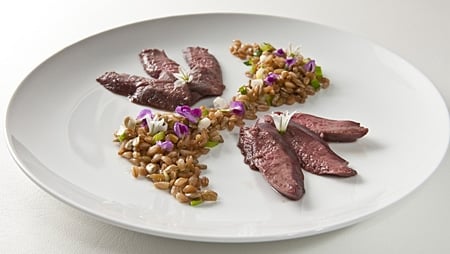
Sharptail grouse is distinctive, unique — and strong-tasting. It is not to everyone’s taste. Unlike most upland game birds, sharpies have dark meat like ducks or doves, and that meat is decidedly gamey. Almost funky. You have to either embrace it or run screaming.
Those who prefer skinless chicken breasts will run screaming. But those of us who like our meat to taste like something can linger over the beguiling taste of this bird, which is native to our Great Plains, for long moments, wondering where this bird has been all our lives. The flavor is acquired, but addicting.
Holly and I shot our first sharpies this past season in North Dakota, which is one of the best places to hunt them in North America. We’ve eaten all but a final brace of our grouse, and I wanted this last sharpie meal to be something special.
I also wanted to see if I could overcome something weird that happens to sharptail grouse meat: It goes from a pretty pink to gray in a heartbeat. Unlike any other meat I’ve ever worked with, the color change is nearly instantaneous. The breast meat can still be juicy and tender once it turns gray, but the color becomes less than appetizing. The answer to this problem is to cook it sous vide.
Sous vide, a water oven, lets you cook at a precise temperature, and, because you use your vacuum sealer to seal the food in, you can also get some dramatic effects with flavor on the meat. The pressure of sealing makes it like a power marinade.
The Plains Indians call the sharptail grouse the “fire bird” because it relies on huge prairie fires to keep its habitat in good shape. So I decided to call my dish “Prairie Fire Grouse,” and make smoke a big component. But since this is kind of a cheffy dish, I was not going to just toss the grouse into the smoker. Smoked salt, however, gives me close to the same effect, especially when it is sealed in with the meat as it cooks.
Whenever I try to figure out what to serve with wild food, I think about something the great British chef Marco Pierre White once said: “Nature is the artist. The chef is just the technician.” What goes together in life will go together on the plate. That idea provides the road map to the final dish.
For starters, these sharpies had been eating rose hips. So I decided to make a rose hip gastrique by melting rose hip jelly with salt and vinegar and glaze the grouse with this.
I knew grain would have to be in here somewhere, as North Dakota is one of those “amber waves of grain” states we all sang about in grade school. So I made a stock from the rest of the grouse (I was only using the breasts in the recipe) and cook farro in it; farro is an ancient form of wheat. As it happens, NoDak is also one of the nation’s largest producers of sunflowers — so in would go sunflower seeds, and sunflower oil.
Wild onions, which grow everywhere, would make an appearance, too, and I’d use malt vinegar — also from grain — to brighten up the flavors. Garnish? Onion flowers and some pretty purple vetch flowers growing in my yard; vetch is a relative of the bean or pea and it grows wild all over the country.
The dish looks simple, but there is a whole lot going on there.
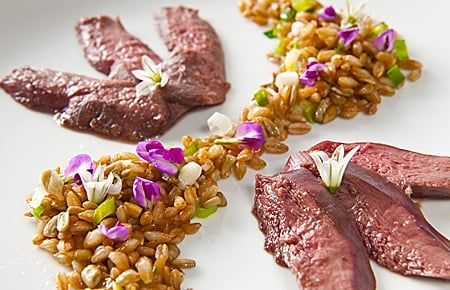
Can you make this dish at home? You can get close, with some substitutions, which I will outline below. Is it worth it? Oh, yes.
This recipe tastes as good as it looks. The grouse is meltingly tender, a little smoky and sweet-and-sour from the rose hip glaze, yet still a bit funky (because it is sharptail grouse, after all). The farro is surprisingly light, and the wheat-malt vinegar-sunflower seed-green onion mixture really, really works. The magenta vetch flowers add some beauty.
Everything on the plate is a flavor of our Great Plains. And I bet you thought it was just Flyover Country, didn’t you?
Sharptail grouse, prairie flavors
Ingredients
GROUSE
- 2 sharptail grouse or prairie chickens
- 1 tablespoon smoked salt
- 2 tablespoons sunflower oil or other neutral oil
ROSE HIP GASTRIQUE
- 1/4 cup rose hip jelly, or apricot jelly
- 2 tablespoons white wine vinegar
- 1/4 teaspoon salt
FARRO
- 1 1/2 cups farro or wheat berries
- 1 quart stock or broth (any kind)
- 1 teaspoon smoked salt
- 1 teaspoon regular salt
- 2 tablespoons sunflower oil or other neutral oil
- 4 green onions, white parts and green parts separated
- 3/4 cup shelled, roasted sunflower seeds
- 1 tablespoon malt vinegar
- Onion or vetch flowers to garnish (optional)
Instructions
- Coat the grouse with the sunflower oil and sprinkle with the smoked salt. Seal in a vacuum bag and cook sous vide at 138 degrees for 30-50 minutes. If you are not cooking the grouse sous vide, wait to cook it until after the farro is done.
- To make the gastrique, melt the jelly in a small pot over medium heat, then whisk in the vinegar and salt to combine. Turn off the heat and set aside.
- Bring the stock to a boil, add both salts then the farro. Simmer this gently until the grains are tender, about 30-40 minutes. Drain the farro and discard any remaining stock, or use it in another recipe.
- Heat the sunflower oil over medium-high heat in a large saute pan and saute the white parts of the green onions for 1 minute, stirring often. Add the cooked farro and the sunflower seeds and toss to combine. Add salt to taste. Turn off the heat and cook your grouse if you are not cooking it sous vide.
- To finish the grouse, take it out of the vacuum bag and let it rest a couple minutes, then slice it thin. Do the same if you've sauteed the breast. Bring the rose hip gastrique to a boil, turn off the heat and pour it over the grouse slices. Toss well and serve.
- To finish the farro, turn the heat on to warm it through, then toss in the green parts of the onions and the malt vinegar and serve at once.
Nutrition
Nutrition information is automatically calculated, so should only be used as an approximation.
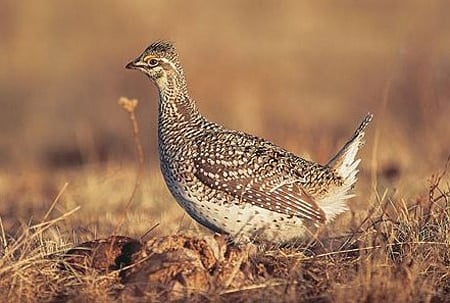
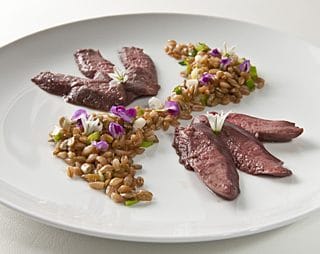
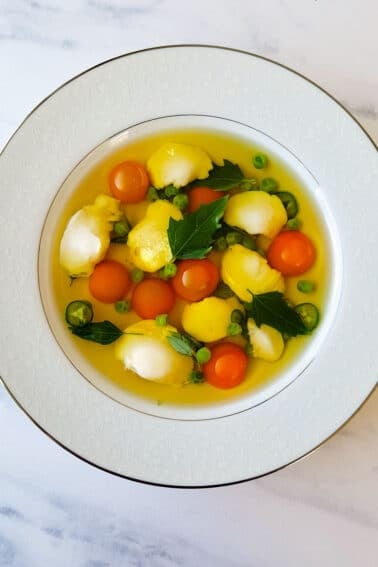
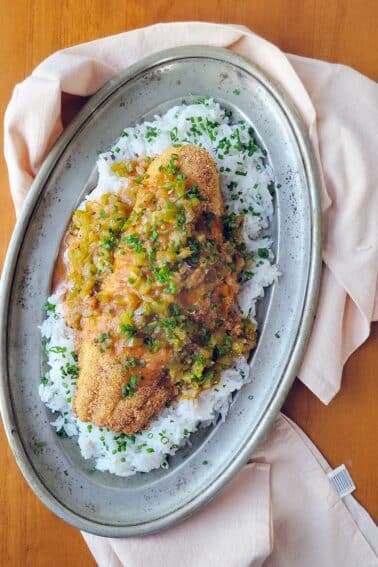
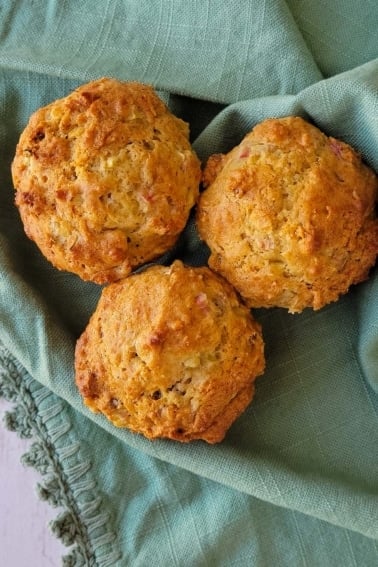

Hey Hank. This is a bit behind, just saw this recipe. I was curious about the lack of pre or post sous vide sear on the grouse breasts. seems like a little Maillard wouldn’t hurt. Your thoughts? Thanks,
ML
Mike: Sure, if you’d like. Do it post sous-vide. I just liked the poached meat texture in this case, but searing is never a bad idea.
Greetings Hank,
Living as I do in Western Mass. the hunting and fishing is not surpassed by many states. However, there are species that do elude us. Based upon what we have here I can agree with you that the Ruffled Grouse, partridge, is one of the finest eating.
I hunt and fish the Berkshires, as well as Southern Vermont, so there is a plethora wild game to enjoy.
Now, the purpose of this post is to tell you that I seriously enjoy your recipes, but more so, the “stuff” behind them. By that I mean the understanding of the blending of spices and cooking techniques that gives that ‘je ne sais quoi’ to the ordinary. Thank you! 🙂
Huggs & B*B ~ OwlOak
Love the concepts behind the dish, and it’s a pretty one indeed. Well done.
Tyler: Oh yeah, the flavor is pretty different from duck. Sharpies definitely stand on their own.
Chris: Nice hack!
Tovar: You are lucky to have tasted them, living in Vermont as you do. You are in the land of the Ruffed Grouse, which is even better tasting IMHO.
Tasha: Big fan of goat in all its forms. People are so used to their meat being corn-fed, fatty and bland that when they get real meat it freaks them out. A sad state of events, actually.
‘Those of us who like our meat to taste like something…’ – YES! I recently posted a curried lamb pizza and several people commented that they didn’t really like the gamey taste of lamb (or goat) and I was wondering…do you want you meat to taste like nothing? Why????
This looks absolutely delicious. A gorgeous plate of food.
A good friend of mine from here in Vermont makes an annual pilgrimage to Montana, specifically to hunt sharpies. He has prepared some for us once or twice. Delicious.
for those who don’t have a dedicated sous-vide cooking apparatus you can achieve similar results using a standard beer cooler:
https://www.seriouseats.com/2010/04/cook-your-meat-in-a-beer-cooler-the-worlds-best-sous-vide-hack.html
Obviously it is not going to give you the same precise control or work with high temps or long cook times but 138 for less than an hour should be no problem.
Very cool! Being from North Dakota, I shoot sharpies all the time during the fall. Going out and hunting them on a bright, sunny afternoon is an especially nice change after shooting a limit of ducks in the morning. Can make for quite an eventful fall day! For years, I’ve always mixed my sharptail grouse breasts in with my ducks. Often, they’re hard to tell apart. I’d definitely like to try cooking them more on their own, however. Last fall was my first time ever eating fresh (never frozen) sharptail. I did the “bacon-wrapped-breast-secured-via-toothpick” trick and glazed the whole deal in BBQ sauce. Tasted much, much better fresh than frozen, and certainly opened my eyes to the possible cooking options for sharptails instead of just throwing them in with the ducks.